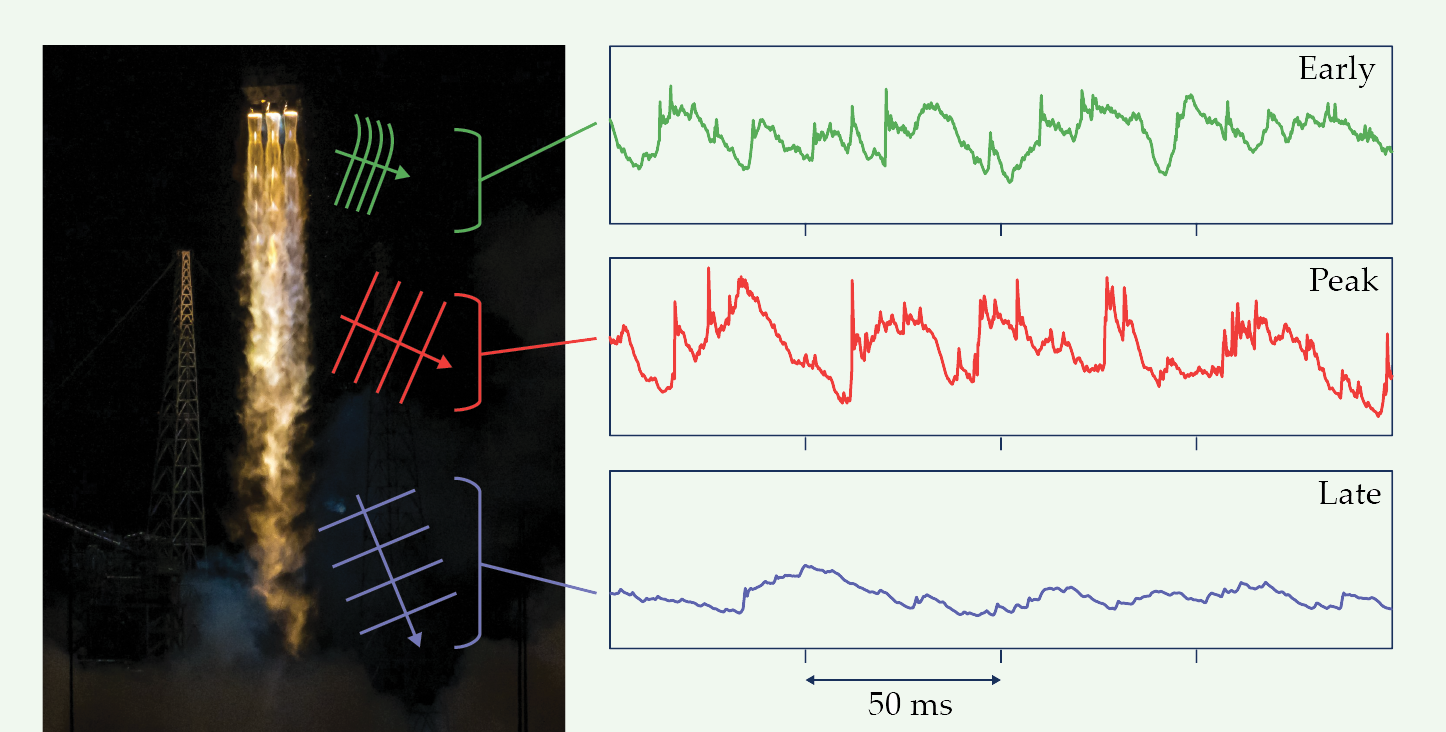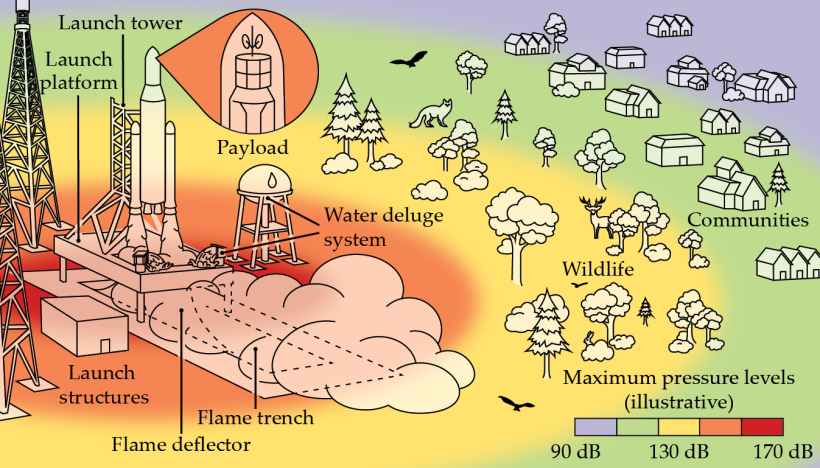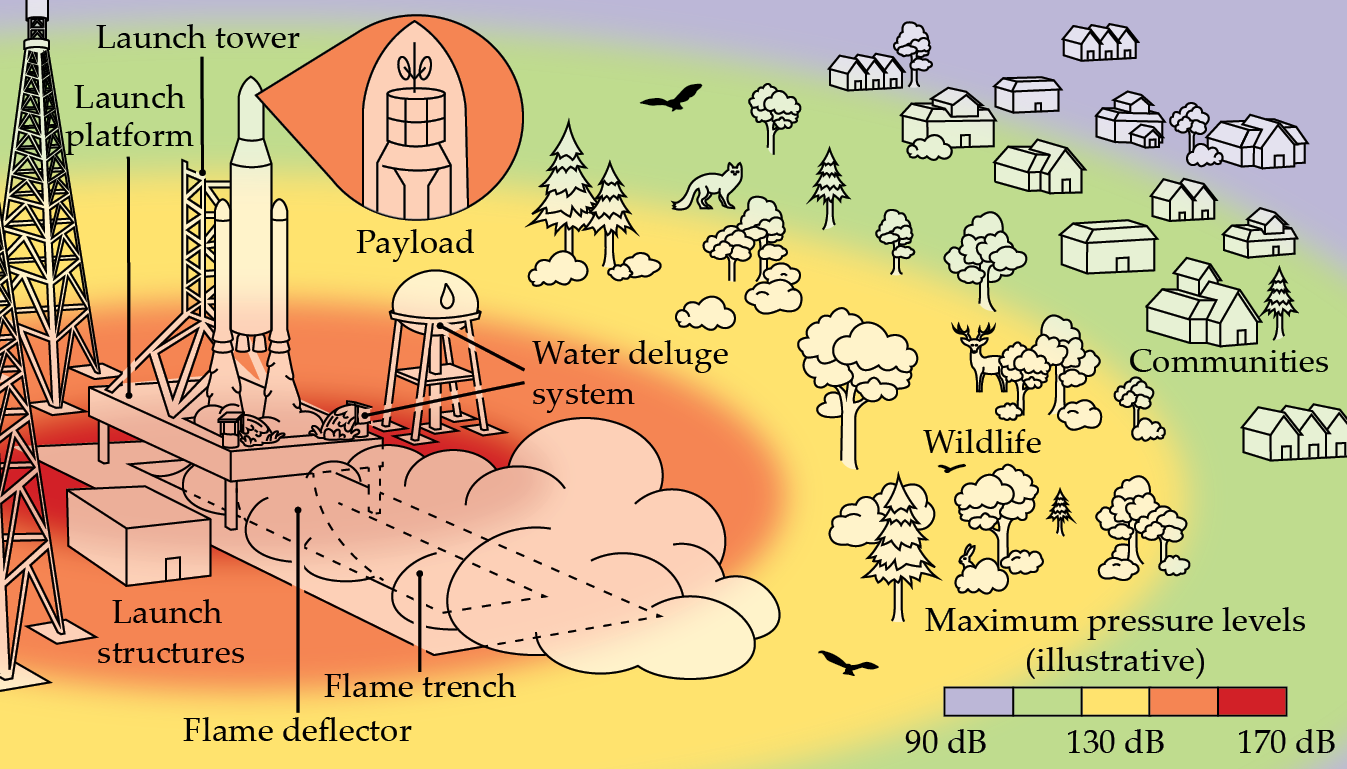The roar of a rocket
DOI: 10.1063/pt.izel.cyox
To say that rockets are loud is an understatement. Few of them are as loud as were NASA’s 1970s-era Saturn V rockets. Its engines generated 45 GW of mechanical power while burning a combined 12 700 liters of kerosene and liquid oxygen every second. The stakes were high. Saturn V rockets carried Apollo astronauts to the Moon and the Skylab space station into orbit.
Thankfully, less than 1% of a rocket’s mechanical power is converted into sound. Even so, the Saturn V radiated nearly 250 MW of sound power. By comparison, a typical gas-powered lawnmower radiates a few tens of milliwatts. It would take around 10 billion lawnmowers to equal the acoustic power of the Saturn V.
Although the number of rocket launches is rapidly increasing each year, only about 220 of them took place in 2023. Compare that number with commercial aviation, which sees 25 000 flights per day in the US alone. But each rocket launch has the potential for far greater impact.
Rockets produce sound waves of sufficient intensity to induce vibrations capable of damaging the rockets themselves, their payloads, and nearby launch-pad structures. Farther afield, a rocket’s predominantly low-frequency noise propagates much longer distances than aircraft noise, such that community and environmental noise concerns are different, but researchers have not yet developed techniques to quantify how people and animals react to rocket noise. The overall noise footprint and damage risk will also increase as global demand for space access surges from the emerging industry of suborbital tourism (see the Quick Study by Jonathan McDowell, Physics Today, October 2020, page 70
This Quick Study describes a rocket’s noise-generation physics and discusses the impacts of that noise.
Power and pressure
Sound is quantified in terms of decibels, which translate SI units—watts for power and pascals for pressure—into a condensed, logarithmic measurement scale. Sound power is an integration of the radiated sound across all angles and frequencies.
A decibel scale has no physical meaning until a zero point is defined. Without that reference a decibel value describes only relative changes, such as a 3 dB increase for a doubling of sound power. For sound, the 0 dB point is 1 pW; for pressure it is 20 μPa. Although a large rocket may generate a sound-power level in excess of 200 dB re 1 pW, maximum overall pressure levels near the rocket plume will be considerably less—somewhere around 170–175 dB re 20 μPa. Both represent extreme sound levels.
Rocket noise sources change during the startup and launch sequence. During engine startup, an ignition overpressure (IOP) often occurs. A supersonic plume of gas emerges from the rocket nozzle, rapidly heating and expanding the ambient air. The high-amplitude pressure transient can be particularly intense for solid-fuel boosters: The IOP peak-pressure level during the recent Artemis 1 launch reached nearly 146 dB re 20 μPa—above the ear’s pain threshold—at a distance of 1.8 km.
Turbulent mixing noise is then created as the plume, leaving the nozzle at velocities of 2500–4000 m/s, interacts with the ambient air to generate large-amplitude pressure fluctuations. That supersonic turbulence results in Mach waves—an efficient form of noise radiation whose directionality depends on the local turbulence velocity and ambient sound speed.
As figure
Figure 1.

Turbulent plumes of exploding gas (left) emerge from the triple-core Delta IV Heavy rocket during the launch of the Parker Solar Probe. The pictured wavefronts (right) represent the changing sound-radiation wavelengths—from green (the shortest) to purple (the longest). Their directionality changes with the local velocity of the gas. Those different wavefronts and directionalities alter the received sound character at 1 km from the rocket during early-, peak-, and late-launch noise phases.

A frequency-dependent noise origin and directionality cause the noise spectrum’s shape, peak frequency, and overall sound level to vary with angle. A person viewing a launch hears a clear downward shift in the pitch of the noise as the rocket lifts off, but that change is caused by the noise-generation physics rather than the Doppler effect. In addition to the IOP and Mach-wave radiation, our understanding of rocket noise is complicated by the plume’s deflection from the flame trench—a deep concrete channel, shown in figure
Figure 2.

Twenty-five hundred tons of hardware and humans typically take off in a rocket launch. To reduce the heat and dissipate the sound, a million or more liters of water are normally released onto the launch pad in under a minute during liftoff. A flame trench below the pad deflects the plume of smoke and flames produced by the rocket boosters. Wildlife and neighbors within several kilometers experience high sound-pressure levels.

It’s not just the long-range sound levels that make observing a rocket launch impressive. The penetrating low-frequency roar and rumble are also accompanied by an intense crackling sound, frequently commented on at space shuttle launches and now generally associated with rockets and high-power military jet aircraft. The crackle is caused by shocks—near-discontinuous pressure jumps—in the noise waveform and result from nonlinear wave phenomena.
Attenuating the noise
The rocket’s noise intensity can create potentially destructive impacts. Figure
To protect the payload, rocket, and launch-pad structures, a huge volume of water is released from a tower nearby that floods the launch platform during liftoff. The inundation typically reduces the noise by 3–5 dB (50–70%) by absorbing sound via bubbles and converting the acoustic energy into heat. Flame trenches also reduce the intensity of Mach and impingement waves that radiate energy back toward the rocket.
The noise also causes environmental and community concerns. Launch complexes often double as wildlife preserves for endangered species, and an increased launch cadence or construction of new spaceports can be worrying. Endangered birds, such as the western snowy plover and the California least tern, nest along beaches at Vandenberg Space Force Base. And NASA’s Kennedy Space Center shares its borders with the Merritt Island National Wildlife Refuge, home to several endangered species.
Noise may startle birds or alter their vocalizations during mating and nesting seasons. In nearby communities, where levels may exceed 100 dB re 20 μPa, low frequencies transmit into homes and cause vibrations that rattle windows, damage historic structures, annoy homeowners, and ruin people’s sleep. Collectively, there is a pressing need to better understand the noise-generation mechanisms, noise propagation, and the multitude of impacts of rocket-launch noise.
The world is entering an era with unprecedented need for access to space. Although researchers qualitatively understand some of the effects of rocket-noise physics and impacts, they still need to develop noise-emission models and metrics that better describe the unique sound characteristics and the associated community and environment effects. Sustained research is needed so scientists can accurately predict and mitigate those impacts—including vibroacoustic and environmental—to launch the new space age.
References
▶ C. P. Lubert, K. L. Gee, S. Tsutsumi, “Supersonic jet noise from launch vehicles: 50 years since NASA SP-8072,” J. Acoust. Soc. Am. 151, 752 (2022). https://doi.org/10.1121/10.0009160
▶ C. P. Lubert, “From Sputnik to SpaceX: 60 years of rocket launch acoustics,” Acoust. Today 14, 38 (2018). https://doi.org/10.1121/AT.2018.14.4.40
▶ National Academies of Sciences, Engineering, and Medicine, Commercial Space Operations Noise and Sonic Boom Measurements, ACRP Project 02-81 final report, National Academies Press (2020).
▶ K. L. Gee et al., “Saturn-V sound levels: A letter to the Redditor,” J. Acoust. Soc. Am. 152, 1068 (2022). https://doi.org/10.1121/10.0013216
▶ K. L. Gee et al., “Space Launch System acoustics: Far-field noise measurements of the Artemis-I launch,” JASA Express Lett. 3, 023601 (2023). https://doi.org/10.1121/10.0016878
More about the Authors
Kent Gee is a professor of physics at Brigham Young University in Provo, Utah. Caroline Lubert is a professor of applied mathematics at James Madison University in Harrisonburg, Virginia. Michael James is a managing partner and chief engineer at Blue Ridge Research and Consulting LLC in Asheville, North Carolina.



